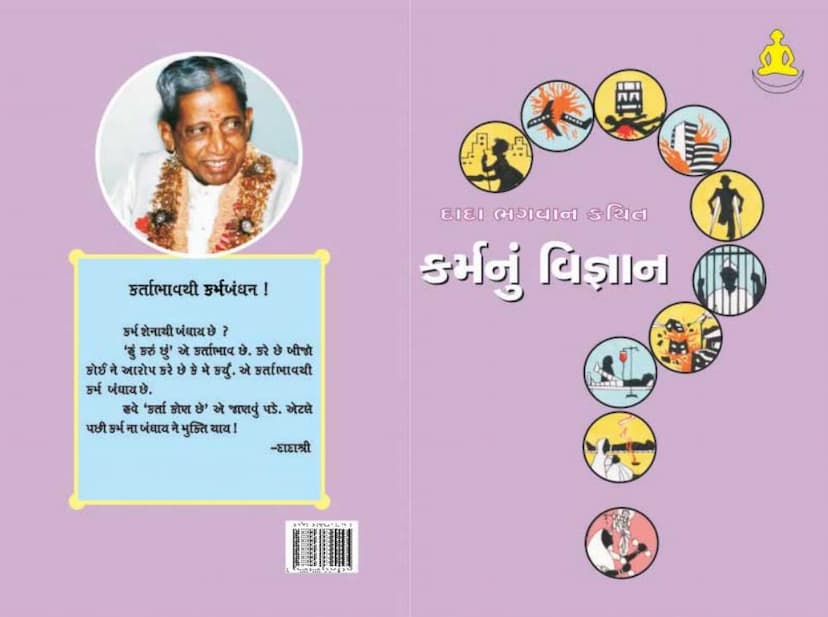Karma Nu Vigyan
Added to library: September 2, 2025

Summary
This document is a summary of the Jain text "Karma Nu Vigyan" (The Science of Karma) by Dada Bhagwan, published by the Dada Bhagwan Foundation. The book delves into the intricacies of karma, a fundamental concept in Jainism that explains the cycle of cause and effect governing an individual's life and future rebirths.
Here's a comprehensive summary of the key points discussed in the text:
Understanding Karma:
- Karma is not just action, but the intention behind it: The text emphasizes that karma is primarily bound by the "kartabhav" (the feeling of doership). When one believes "I am doing it" or attributes actions to oneself, karma is bound.
- The illusion of doership (kartabhav): The core of karma binding is the mistaken belief in being the doer. This illusion arises from ego and false identification with the body and mind.
- Distinction between Karma and Karmapal (Karmic fruit): What is perceived by the senses and is tangible is considered "karmapal" or the discharge of karma from past lives. The actual binding of new karma happens subtly and is not apparent to the ordinary senses.
- The concept of "Vyavasthit Shakti": Dada Bhagwan introduces the concept of "Vyavasthit Shakti" (organized energy) as the governing force of the universe, which orchestrates the unfolding of karmic results. Karma is merely an instrument within this larger, scientifically ordered system.
How Karma is Bound:
- Ego (Ahankar) and Wrong Beliefs: Karma is bound through ego, which involves attributing "I-ness" and "my-ness" to things one is not. Wrong beliefs, such as identifying with the body ("I am Chandubhai") or possessions, lead to karma.
- The "Doer" Illusion: The act of believing oneself to be the doer, even for actions that are a result of external circumstances or past karma, creates new karma.
- Subtle Karma (Sukshma Karma) vs. Gross Karma (Sthool Karma): The text differentiates between gross karma (actions visible to the senses, like giving charity) and subtle karma (internal intentions and beliefs). While gross karma's effects are often visible in this life, subtle karma determines future rebirths and experiences.
- Intention (Bhav) is Crucial: The ultimate binding of karma stems from internal intentions and beliefs, not just external actions. Acting with selfish intent (swarth bhav) creates negative karma (paap), while selfless intent (nishwarth bhav) creates positive karma (punya). However, both are still forms of karma that bind.
The Process of Karmic Results:
- Cause and Effect Cycle: The text illustrates the continuous cycle of cause and effect ("causes and effects"). Actions create causes, which in turn lead to effects. Experiencing these effects can then create new causes.
- Circumstantial Evidence: Dada Bhagwan explains that the unfolding of karmic results is based on "Scientific Circumstantial Evidence," meaning a confluence of factors and conditions are required for karma to bear fruit.
- Sanchit, Prarabhd, and Kriyaman Karma:
- Sanchit Karma: Karmas accumulated from past lives, stored like seeds, waiting to fructify.
- Prarabhd Karma: Sanchit karma that has matured and is ready to manifest as experience in the current life.
- Kriyaman Karma: New karma being created in the present life through current actions and intentions.
- Karma and Rebirth: Karmas determine the nature of future births. Good karma leads to favorable births, while negative karma leads to unfavorable ones. The cycle of birth and death continues until all karma is discharged.
Overcoming Karma and Attaining Liberation:
- Self-Realization (Atmavidya): The ultimate solution to breaking free from the cycle of karma is self-realization – understanding one's true self as the pure soul (Shuddhatma), separate from the body and mind.
- Non-Doership (Akarta Bhav): By realizing that one is not the doer, but rather the witness to actions, new karma is not created. The feeling of "I am doing it" must be dissolved.
- Pratikraman: This is a process of repentance and atonement for past errors, which helps to neutralize the binding effect of karma.
- The Science of the Self: Dada Bhagwan's teachings provide a scientific understanding of the self and the universe, enabling one to live without creating new karma.
- Detachment and Non-attachment: Cultivating detachment from worldly desires and experiences, while still fulfilling worldly duties, is key to preventing the formation of new karma.
- The Role of Knowledge: True knowledge, obtained from a Gnani Purush (a self-realized being), is the ultimate means to understand these principles and achieve liberation.
Key Insights and Analogies:
- The Echo Analogy: Just as an echo repeats what is spoken into a well, our actions and intentions create karmic results.
- The Mango Tree Analogy: A mango seed grows into a tree with fruits, requiring various supporting elements. Similarly, karma requires supporting circumstances to fructify.
- The Loan Analogy: All worldly happiness is like happiness obtained on loan; it must be repaid with suffering later.
- Gross vs. Subtle Actions: The text highlights that what is perceived externally as karma (like giving charity) might be accompanied by subtle negative intentions, leading to different karmic outcomes.
In essence, "Karma Nu Vigyan" by Dada Bhagwan presents a profound, scientific, and practical approach to understanding and navigating the complexities of karma, aiming to guide individuals towards self-realization and ultimate liberation from the cycle of birth and death. The book stresses that true freedom lies in recognizing one's true nature as the pure soul and living in a state of non-doership and detachment.